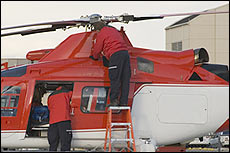|
WHAT CAUSES HELICOPTER ACCIDENTS?
 Helicopters are
complex, sophisticated machines. They consist of engines, rotors,
drive shafts, gears, electronics, flight controls and landing gear,
all of which must function properly both independently and together
for the helicopter to operate safely. These individual systems and
their components must be designed, manufactured, maintained and
operated with the utmost skill and care if the helicopter is to fly
safely. Helicopters are
complex, sophisticated machines. They consist of engines, rotors,
drive shafts, gears, electronics, flight controls and landing gear,
all of which must function properly both independently and together
for the helicopter to operate safely. These individual systems and
their components must be designed, manufactured, maintained and
operated with the utmost skill and care if the helicopter is to fly
safely. Recently, government agencies, industry and operators
conducted their first International Helicopter Safety Symposium
which was held in order to develop means to reduce helicopter
accidents. The accident rate in helicopter flight was flat, or
perhaps increasing attendees noted. The statistics presented showed
that the helicopter accident rate was 7.5 per 100,000 hours of
flying, whereas the airplane accident rate was approximately 0.175
per 100,000 flying hours. As the Symposium’s chairman noted:
“Vertical flight is an exclusive engineering feat that only
helicopters can offer. They operate close to the ground, within the
earth’s boundary layer and are exposed to hazards beyond other
flight vehicles. It therefore requires special attention to ensure
safety of flight.” This is true in general of helicopter operations,
and particular types of helicopter operations—military,
fire-fighting, law enforcement, medical evacuation—are even more
demanding. The causes of helicopter accidents can be grouped into
three major causal areas: Operational error, mechanical malfunction,
and electrical malfunction. Within these broad categories, there are
multiple underlying causes. 1. Operational Error. Although all
three categories involve some degree of human error, operational
error is the one where the human error is most direct and apparent.
This human error can occur in flight planning, actual conduct of the
flight, in training or in maintenance.
a. Failure to operate the aircraft in accordance with the aircraft’s
operational limitations.
b. Operating the aircraft in unsafe environmental conditions.
c. Failing to properly plan the flight.
d. Improper maintenance
e. Improper training of flight and maintenance personnel
f. Faulty manuals, training guides, checklists and operational
procedures
g. Faulty oversight, auditing and review procedures 2. Mechanical
Malfunction. A component of the aircraft fails or fails to function
as intended. This can happen anywhere along the component’s life.
a. Improper design
b. Inadequate testing
c. Faulty manufacture
d. Inadequate quality control
e. Inadequate operational monitoring
f. Improper use
g. Poor maintenance
h. Inadequate lubrication or cooling
i. Improper installation 3. Electrical Malfunction Here, the
electrical source stops working or one of its components has a
malfunction. a. The electrical source
malfunctions
b. An electrical short occurs
c. An electrical component malfunctions
d. Inadequate design
e. Inadequate testing
f. Inadequate quality control
g. Inadequate operational monitoring Each of these elements of the
three major causal areas contains its own subset of individual
factors as to exactly why and how it occurs. Sometimes these factors
result in minor or no aircraft damage or injury, but all too
frequently they cause great aircraft damage and personal injury,
even death. One thing is true as to all causes: they are
preventable.
>> Next Page
|